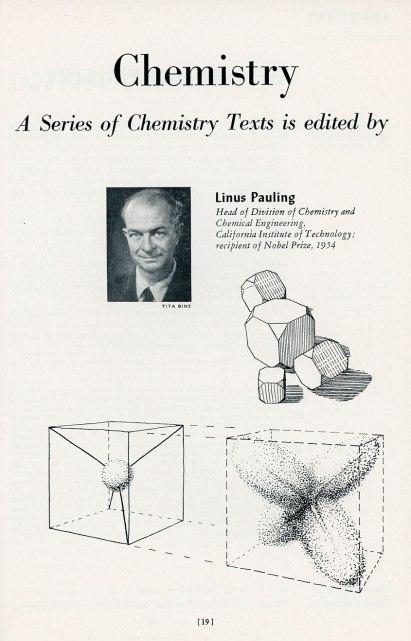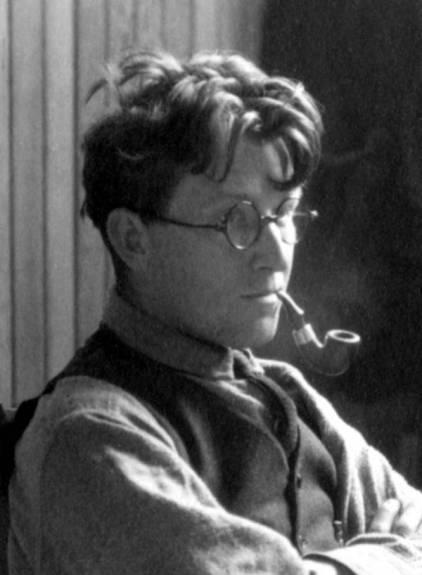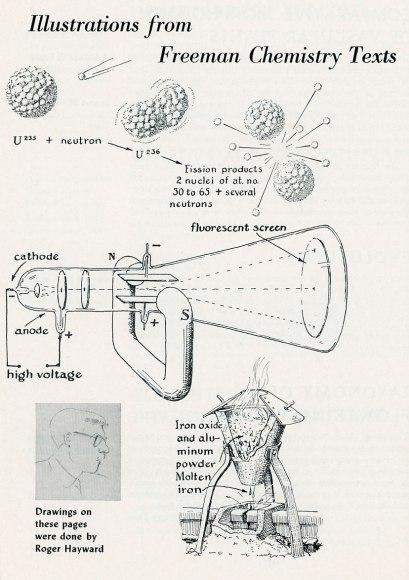
[Ed Note: In November and December 2017, we explored Linus Pauling’s connections with the publishing house W.H. Freeman & Co. as viewed through the lens of Pauling’s groundbreaking textbook, General Chemistry. Today we begin a new series that delves more deeply into that relationship, exploring Pauling’s interactions with Bill Freeman the man and W.H. Freeman the company. This is part 1 of 8.]
William Hazen Freeman, Jr. was born in New York state in March 1905. Though information about his early life is scant, we do know that his father, William Hazen Freeman, was a doctor who specialized in gastrointestinal issues. The younger Freeman attended Hamilton College in New York and graduated in 1926, a member of the same class as famed behaviorist B.F. Skinner.
Macmillan Publishing Company had already hired Freeman by the time of his graduation and, over the next few years, he rose to an editorial position within the company’s textbook department. In the midst of this, Freeman relocated to San Francisco, where he began work at the company’s newly opened satellite branch.
Not long after arriving on the West Coast, Freeman met with Linus Pauling for the first time. Macmillan was keen to publish a series of textbooks in chemistry, and Freeman felt that Pauling would be the ideal editor for such a series. Furthermore, Freeman saw any potential partnership as mutually beneficial: Macmillan would enlist the skill, expertise, and reputation of a prominent scientific figure who had built a strong reputation as a teacher and Pauling could use the association with a large publishing firm to develop his own series of textbooks.
Though Pauling couldn’t deny that this sounded appealing, he hesitated. For one, he disliked the idea that he wouldn’t retain authority over the direction of the series. Rather, Macmillan planned to select the books that would be published and then pass them on to Pauling for his input. Moreover, the publisher wanted Pauling to coordinate closely with a team of Macmillan editors throughout the process. The company also suggested that they would likely terminate the series after just a few years. Taking all of these factors into consideration, Pauling thanked Freeman for his time and declined the offer.
In 1941, when Pauling began circulating early drafts of General Chemistry, Freeman approached him again, this time to express Macmillan’s interest in the manuscript. Though Pauling chose not to publish with Macmillan, the two stayed in contact through the war years, even though Pauling had postponed work on all major writing projects.

While Freeman was working in San Francisco, he met Verne Kopplin, a young lawyer who was specializing in tax law. A graduate of the University of Wisconsin, Kopplin was the 106th woman to practice law in the state. She subsequently passed the bar in Massachusetts and California, and was ultimately hired by the prestigious San Francisco firm of Rogers and Clark, which had previously abstained from employing women as attorneys. Indeed, by the time that she became involved with Freeman, Kopplin had already challenged discriminatory gender practices in three states.
Freeman and Kopplin married in 1946, the same year that W.H. Freeman & Company opened for business. In each other, they recognized a mutual determination to succeed, even if they had to challenge powerful institutions to do so. For Freeman, this ambition meant leaving Macmillan when it failed to show enough genuine interest in Pauling’s General Chemistry manuscript. Freeman also fiercely believed in small, independent presses and the importance of developing a trusting and intimate relationship between authors and publishers. He once remarked to illustrator Roger Hayward, with whom he shared a deep personal friendship for many years, that “the relationship between an author and a publisher is something like a marriage.”
Macmillan’s lackluster interest in Pauling’s text was indeed the spark that led Freeman to create his own publishing house, and it was a gamble that paid off. In 1947, W.H. Freeman & Co. published its first book, General Chemistry, now regarded to be a classic of the genre. That same year also brought success for Verne, as it marked the beginning of her practice at Rogers and Clark. She remained there for eight years before establishing her own practice. During her time in California, she also acted as a consultant for Freeman & Co., typically providing guidance on matters related to stockholders.

Freeman set up shop on Market Street, a major San Francisco thoroughfare that promised high visibility for his fledgling company. Freeman’s boldness of vision matched well with the prominence of his chosen location. As he stated in his first corporate mission statement: “We say first of all that we want each book we publish to be something that hasn’t been done or that has not been well done.” As a first order of business in pursuing this objective, he revived the idea of a chemistry series for which Pauling would be the sole editor.
Once Pauling was officially on board, Freeman began sending his new editor several manuscripts each month, curating Pauling’s feedback about each submission’s potential for success. In addition to providing suggestions on whether or not a given book should be published, Pauling’s responsibilities as editor of the series also included bringing new manuscripts to Freeman’s attention. Once a proposal was accepted, Pauling provided further suggestions as the text went through the process of development. He did all of this while also writing and editing his own books.
Pauling was an exacting reader and often much sterner than Freeman in his evaluations. Indeed, he rejected most of the manuscripts that Freeman and, later, Stanley Schaefer sent to him. For one physical chemistry proposal that Pauling judged to be particularly poor, he told Freeman, “If you have any thought of publishing this, send it back to me and I’ll tear it to pieces for you.” Freeman replied sympathetically, noting that he found life as an editor to be mostly unsatisfactory, except in cases where he encountered writing like Pauling’s.
Those few manuscripts that did receive Pauling’s blessing were generally qualified with a long list of criticisms. For a general chemistry text authored by Arthur Campbell, Pauling sent four to five pages of revisions per single manuscript page — the book took several years to publish. It wasn’t Pauling’s intention to be unduly harsh. Rather, his thorough critiques reflected his steadfast commitment to improving the quality of scientific education. It was important to Pauling that his series only release texts that were current, unique, and highly effective. In this, he did much to reinforce Freeman’s mission statement.
However, as the 1950s moved forward and Pauling became busier, he found that there was far less time to devote to editorial responsibilities. By 1956, Freeman had become fairly concerned and, in one instance, he pressed Pauling to take a look at a book on hydrogen bonding. In doing so, he reiterated that, “I am very anxious to publish something worthwhile and of a specialized nature in your series, for it is not good to have your series show as little activity as it has.” Thus motivated, Pauling refocused his efforts and returned the manuscript a short while later, offering few critical comments.

Roscoe Dickinson, 1923.
Though the series was overall a success, not every project worked out. One particularly tantalizing idea that Freeman put forth was for Pauling to collaborate with Caltech colleagues Richard Badger, David Shoemaker, and Stuart Bates to compile and contextualize a series of notes written by Roscoe Dickinson. (Pauling’s major professor and the first person to earn a Ph.D. from Caltech, Dickinson died in 1945 at the young age of 51.) Freeman’s idea came from requests that a book be written on Dickinson’s unpublished work in chemical thermodynamics. Unfortunately, the project never came to fruition for a number of reason, including lack of access to Dickinson’s papers.
Another possibility that went unrealized was an idea that Pauling flirted with from time to time: writing a high school textbook. Freeman successfully dissuaded Pauling from pursuing this notion by enlisting the help of his personal secretary, Margaret Cooper.
Freeman hired Cooper in 1953 and quickly came to respect her opinion on all sorts of matters. Based on her experience as a former high school teacher, she explained to Pauling and Freeman that the American education system had inadequately prepared high school students and instructors alike. In making this suggestion, she pointed out that, while a degree in education technically qualified individuals to teach all fields, in certain instances she felt that she had been forced to provide instruction in subjects for which she lacked the necessary skill set. This anecdote helped Freeman to convince Pauling that writing a text for high school students wasn’t a good use of his time as the content would too often fall upon deaf ears.

But most of Freeman & Co.’s projects found a happy medium between the sensational success of General Chemistry and the trapped potential of the Dickinson text, and overall Bill Freeman was pleased by his company’s success. Notably, at the end of 1949, the publisher was able to put out its first catalog of books. Freeman was quick to point out that most publishing houses were “in the red” for their first five years, but this was not the case for Freeman & Co. Rather, after only three years, the firm had published eight titles and favorably impressed numerous colleges with their small but successful operation.
Outside of their professional association with each other, Pauling and Freeman also formed a close personal friendship. They visited one other as frequently as their busy schedules allowed, and their respective families also became close. In a letter to Pauling, Freeman remarked, “I gather that Lin [daughter Linda Freeman] fell in love with Crelly [son Crellin Pauling] even as Verne fell in love with Peter [son Peter Pauling]. I’ll have to watch the women in my family around your boys.”
(Like Pauling, Freeman had a daughter named Linda. He and Verne also had a son.)
Pauling’s immense faith in Freeman’s abilities matched Freeman’s deep respect for Pauling’s life and work. The two often brought potential projects to one other, with Freeman suggesting at one point that Pauling star in a series of instructional science films. Who knows? Had he taken Freeman’s suggestion to heart, Linus Pauling could have been the Bill Nye of the 1960s!
Advertisements